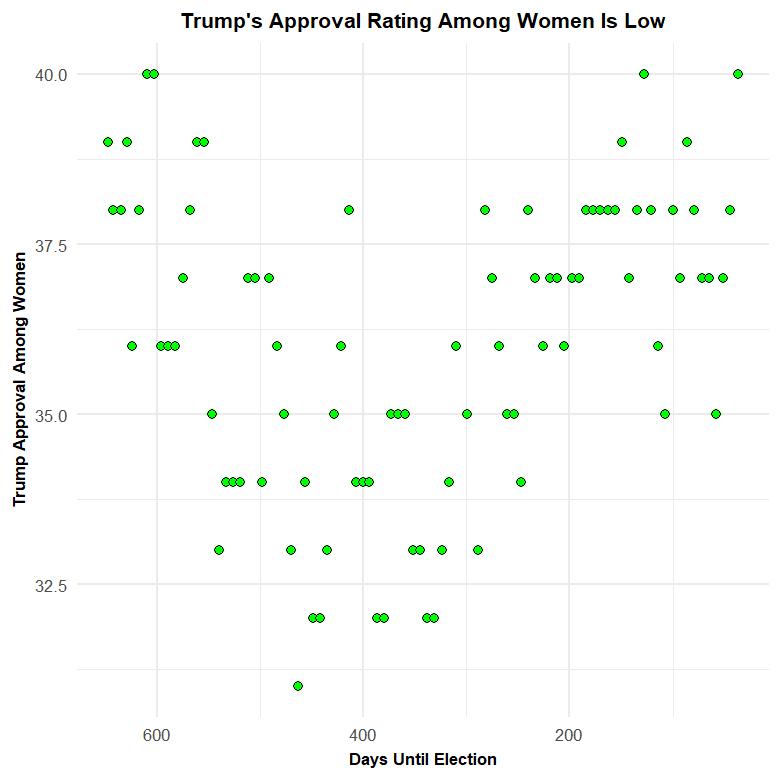Supreme Court confirmations are usually contentious, but Brett Kavanaugh’s process was more intense than usual. And now that the confirmation process, complete with accusations of sexual assault an an FBI investigation, is over and the midterms are only a few weeks away, political observers have been asking the obvious question: Will Kavanaugh matter in November? And will his confirmation shape the gender divides in the 2018 vote?
We don’t yet have the polling data necessary to definitively conclude that Kavanaugh will end up helping either party in the midterms. But we can take a look at the polling data over the last couple weeks to see who recent events initially helped (which seems to be the GOP), and we can get some context that’ll help us understand what upcoming polls and the gender gap.
Kavanaugh Bump—and then Bust?
There’s some evidence that the controversy surrounding the Kavanaugh nomination initially gave the GOP a boost. During the tail end of the Kavanaugh confirmation process, THE WEEKLY STANDARD’s Senate forecast, the RealClearPolitics average of Trump’s approval rating and other major indicators seemed to pick up on a modest GOP bump during the final stages of Kavanaugh’s confirmation process.
There’s an easy, intuitive explanation here—that Republicans who disliked Trump or thought of Democrats as an acceptable alternative came back home while watching Kavanaugh’s confirmation process. The evidence from red states seems to support that explanations: My forecast showed movement toward Ted Cruz in Texas, Marsha Blackburn in Tennessee and Kevin Cramer in North Dakota over that interval. And we haven’t seen corresponding movement in purple state polls (like Nevada and Florida). That suggests that in red states, Republicans reacted to the hearings by rallying around Republican candidates.
Kavanaugh was just confirmed on Saturay, so we can’t conclude that the bump is gone or that it’s here to stay.* You could make the case that it’ll be lasting—that is, that Republicans have reacted favorably to policy victories before (e.g. passing tax cuts seemed to coincide with an increase in Trump’s favorability) and they will do so again for Kavanaugh.
But, if I had to guess, I would guess that the bump will fade. Republicans seemed more energized and united during the Kavanaugh fight, but that fight is over. Within a week or two, the news cycle will probably move on to other stories (Nikki Haley’s resignation is just one exampe). And Trump will likely do something to remind Trump-skeptical Republicans why they’re skeptical, and GOP voters who were fired up about Kavanaugh will have one less reason to turn out. I’m not sure whether Democratic enthusiasm will return to its previous levels or increase in the coming weeks, but either way I expect the GOP to keep trailing by at least mid-to-high single digits in the generic ballot.
Kavanaugh and the Gender Gap
The fight over Kavanaugh raises another obvious question about gender and the election: Will we see a change in gender-specific voting patterns post-Kavanaugh?
Again, we don’t have quite enough polling to draw out a trend and figure out what’s going to happen. But we do have a couple interesting, useful data points that can provide context.
First, the current eye-popping gender gap in the polling data probably isn’t due to Kavanaugh alone. Take a look at this data from Pew Research
It shows that there’s a decrease in GOP affiliation among women and an increase in Democratic affiliation between 2015 and 2017.
Demographic trends are complicated and it can be hard to figure out exactly why one group moves in one direction or another. But between 2015 and 2017, the GOP did undergo one big change that would obviously hurt it with women (—a Republican who says stuff like this about women won the GOP nomination and became the president.
And since inauguration, Trump’s approval among women has been relatively low.

So if we see some larger-than-usual gender gaps in the polls in the coming weeks, we should remember—this probably wasn’t all Kavanaugh. It probably has a lot to do with the political choices that Republicans made over the last three years (and prior to that, when a smaller but still very real gender gap existed).
Second, this is a midterm election so turnout will matter(—both among Democratic women and Republican women.
Turnout among Democratic women has been covered well by a variety of media outlets. The basic narrative has been around for a while: that Trump energized Democratic women (especially well-educated suburban women) and that high turnout numbers in that group would help women win.
But there’s a second side to that equation that also matters. There are a significant number of Republican women—37 percent as of 2017 according to Pew, with 42 percent of all women voting for Trump. If these women feel less than energized by Kavanaugh (or a host of other issues, including Trump himself) then that’ll add to the GOP’s problems.
Finally, a gender gap by itself doesn’t guarantee a win—but Democrats seem to be benefiting this time around.
Historically, Republicans have often faced a gender gap—they almost always perform better with men than women. But that gap alone doesn’t keep the GOP from winning. There was a gender gap in 2016, 2014, 2010, 2004 and numerous other years when the GOP won. In some of those years, Republicans won by running up the score with men, and in 2010 they barely won women. So a gender gap can at times lead to a GOP victory.
But this year doesn’t look like one of those years. Republicans don’t seem to have enough support among men to balance out their large deficit with women. Polls could still change some, but there’s a relatively small amount of time left before Election Day. And so far, this election still looks like it’ll be rough for the GOP.
